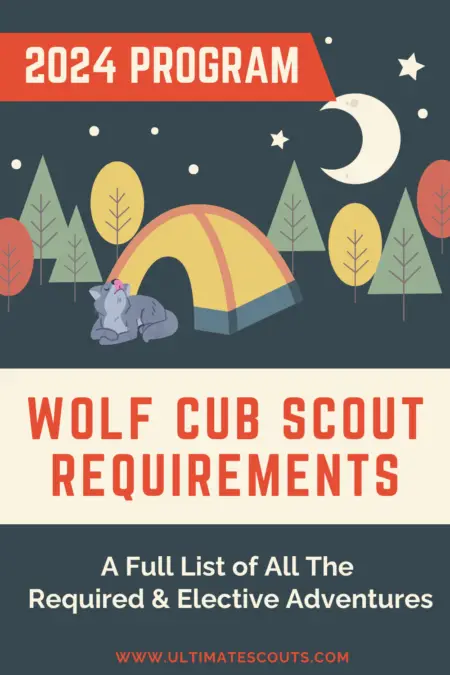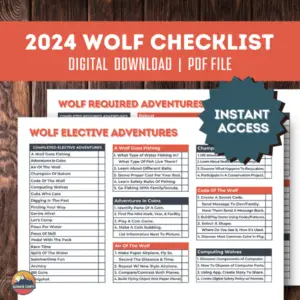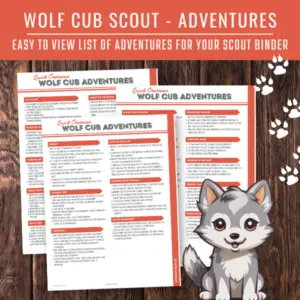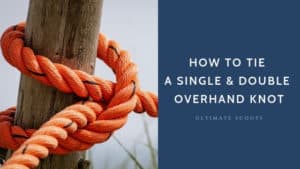What Are The Cub Scout Wolf Requirements? (2024)
What Are The Cub Scouts Wolf Requirements? (2024)
Starting June 2024 Wolf Cub Scouts will need to compete 6 Required Adventures and 2 Elective Adventures of their choice from over a dozen electives to choose from.

Find What You Want Fast - Table of Contents
Wolf Cub Scout - Required Adventures
The following 6 Adventures are required for a Wolf Scout to receive their Wolf badge. You can see all the details in the Wolf Scout Handbook or the Wolf Den Leader Guide. If you are looking for a quick way to see all of the adventures and requirements we have created a printable “cheat sheet” that gives a quick overview of all the activities that can be placed in your Scout Binder for quick reference.
- Get to know the members of your den.
- Recite the scout oath & scout law with your den & den leader.
- Share with your den or family a time when you demonstrated the Cub Scout motto, “Do your best”.
- At home with a parent or legal guardian, do the activities in the booklet “How to Protect Your Children from Child Abuse: A Parent’s Guide.”
- With your den, create a code of conduct.
- Learn about the scout oath. Identify the 3 points of the scout oath.
- Learn about the Denner position & responsibilities.
- Demonstrate the cub scout sign, handshake, and salute. Show how each is used.
- Learn how to properly care for and fold the United States flag. With your den or pack, participate in a flag ceremony.
- Identify 3 parts of the Scout Law that are important to being a good neighbor.
- build a model of your home.
- Using the same materials from requirement 3, create a model of a building that you visit.
- Using the models built, create a neighborhood.
- Participate in a service project. Explain how your volunteering is helpful to the neighborhood.
- With your parent or legal guardian talk about your family’s faith traditions. Identify 3 holidays or celebrations that are part of your family’s faith traditions. Make a craft or work of art of your favorite family’s faith tradition holiday or celebration.
- With your family, attend a religious service or other gathering that shows how your family expresses reverence.
- Carry out an act of kindness.
- Listen to and read Aesop’s fable, “The Boy Who Cried Wolf” with your den or family, and discuss why being truthful is important.
- Identify the Cub Scout 6 Essentials. Show what you do with each item.
- Learn about the buddy system and how it works in the outdoors. Pick a buddy for your walk.
- Identify appropriate clothes and shoes for your walk outside. do your best to wear them on your walk.
- learn about the outdoor code and leave no trace principles..
- With your den, pack, or family, take a walk outside spending at least 30 minutes exploring nature. Describe 4 different animals, domestic or wild, that you can see on your walk.
- Sample 3 different foods that are naturally 3 different colors. The food must be a protein, fruit, dairy, or grain.
- Demonstrate the proper way to brush your teeth.
- Be active for 30 minutes with your den or at least one other person. That includes both stretching and moving.
- Be active for 10 minutes doing personal exercises.
- Do a relaxing activity for 10 minutes.
- Review your BSA Annual health & medical record with your parent or legal guardian. Discuss your ability to participate in den & pack activities.
- With permission from your parent or legal guardian watch the “Protect Yourself Rules” video for the Wolf Rank.
- Discuss “Safe Touch” as seen in the video.
- Learn about the buddy system and demonstrate how it works.
- Review common safety rules & demonstrate the proper use of playground equipment.
Wolf Cub Scout - Elective Adventures
The following 13 Adventures are elective adventures. Only 2 of the 13 have to be completed to earn the Wolf Badge. All of the adventures are broken down in the Wolf Scout Handbook or the Wolf Den Leader Guide.
- Identify the type of water you will be fishing in and what type of fish live in the water.
- Learn about the different types of bait used to attract fish.
- Demonstrate a proper cast for the pole or rod you are using.
- Learn the rules of fishing safely.
- With your den, pack, or family go fishing.
- Identify different parts of a coin.
- Find the mint mark on a coin. Identify the mint where the coin was made and the year it was made.
- Play a coin game.
- Choose a coin that interests you, and make a coin rubbing. List information next to the coin detailing the pictures on it, the year it was made, and the mint where it was made.
- Make a paper airplane and fly it 5 times. Record the distance and time.
- Make a paper airplane of a different design & fly it 5 times. Record the distance and time.
- Compare & contrast the 2 paper airplanes by distance and flight time.
- Build a flying machine that is not a paper airplane.
- Discover the difference between renewable natural resources & nonrenewable natural resources.
- Learn about the 3 R’s – reduce, reuse, recycle.
- Discover what happens to recyclables in your community.
- Participate in a conservation project
Code Of The Wolf
- Create a secret code. Send a message to a member of your den or family. Have that person send a message back to you using the same secret code.
- Build & play a game that requires the use of codes and patterns.
- Select a single shape. Observe the environment around you. Write down where you see that shape and how it is being used.
- Using a package that contains a number of different colored items, discover the most common color.
- Discover the basic components of a computer.
- determine how to properly dispose of computer components.
- Using a digital device application of your device, create a story that you can share with others.
- With your parent or legal guardian, set up a policy for safely using digital devices.
- Explore what it is like to have a physical disability.
- Explore what it is like to have a visual impairment.
- Explore what it is like to have a hearing loss.
- Explore barriers to getting around.
- Play a dinosaur game that shows what you know about them.
- Create an imaginary dinosaur. Share with your den or family its name, what it eats, its size, and where it lives.
- Be a paleontologist and dig through a dinosaur dig.
- Build a fossil layer.
- Using a map, locate where you live.
- Draw a map for a friend to locate your home or school. Create a key for your map.
- Find the directions North, South, East, & West, and the compass rose on a map.
- Find the directions north, south, east, & west using a compass.
- Practice using both a map & a compass.
- Wash your hands while singing the “Happy Birthday” song 2 times.
- Play Germ Magnet with your den or your family. Wash your hands afterward.
- Conduct the sneeze demonstration.
- Conduct the mucus demonstration.
- Grow a mold culture. At a den or pack meeting, show what formed at a den or pack meeting.
- Learn about the buddy system and how it works in the outdoors.
- Know the Cub Scout Six Essentials.
- In addition to your 6 essentials, list the personal items you need for your campout.
- Learn a camping skill.
- Attend a council or district cub scout overnight camp or attend an overnight campout with your pack.
- With your den, discuss sportsmanship and what it means to be a good sport. Make the connection between sportsmanship & the scout oath & scout law.
- Learn the rules of a team sport that you can play with your den, pack, family, or friends. After learning the rules, play the game for 30 minutes.
- Visit or watch a team sporting event with your family or den. Look for ways the team works together & share with your family or den.
- Show how to properly wear a bicycle helmet. Show you can take it off and on without help.
- Decide what you should wear when riding a bicycle.
- Learn about different types of bikes and when & where you might ride these bikes.
- Demonstrate you can stop & start your bicycle without any help.
- Demonstrate proper hand signals
- With your den, pack, or family, following the buddy system take a bike ride.
- With your Adult Partner, assemble & decorate either a Pinewood Derby car or a Raingutter Regatta.
- Learn the rules of the race for the vehicle chosen in Requirement 1.
- Identify how you could increase the speed of your chosen vehicle.
- Before the race, discuss with your den how you will demonstrate good sportsmanship during the race.
- With your AP, participate in a Pinewood Derby or Raingutter Regatta race.
- Learn about the swimming safety rules you need to follow.
- Demonstrate how to enter the swimming area safely.
- Using the buddy system & staying within your ability group go swimming with your den or family for 30 minutes.
- Attempt at least one swimming stroke: Front crawl, restful backstroke, or breaststroke.
- Jump feet first into water that is chest-high or deeper.
- Demonstrate how to exit the swimming area properly
- Discover where the water in your home comes from.
- Discuss how water can become polluted.
- Share some ways you can conserve water in your home.
- Discover how water in your community is treated to become safe to drink.
- During the months May- August participate in a total of 3 Cub Scout activities.
- Identify & wear the appropriate safety gear.
- Recite the archery range safety rules & whistle commands.
- Demonstrate proper range commands.
- Identify the main parts of your shooting equipment & How to properly use them.
- Demonstrate proper stance & shooting techniques.
- Shoot 5 arrows at a target. repeat & do your best to improve your score. Shoot at least 10 arrows.
- Demonstrate how to safely retrieve your arrows.
- Discuss how to put away & properly store your archery shooting equipment after use.
- Explain what you should do if you find a gun. Recite the 4 safety reminders.
- Identify and wear the appropriate safety gear.
- Demonstrate proper range commands.
- Show how to use the safety mechanism.
- Demonstrate how to properly load, fire, & secure your BB gun.
- Demonstrate one of the positions for shooting a BB gun.
- Fire 5 BB’s at the target. With the help of your AP score your target. Repeat and do your best to improve your score. Fire at least 10 bb’s.
- Discuss how to put away & properly store your bb gun & shooting equipment after use.
- Identify & wear the appropriate safety gear.
- Recite the archery range safety rules for using a slingshot.
- Demonstrate proper range commands.
- Identify the main parts of your slingshot & their usage.
- Discover the types of ammunition that may be used & not used.
- Shoot 5 shots at a target. repeat & do your best to improve your score. Shoot at least 10 shots.
- Discuss how to put away & properly store your slingshot & shooting equipment after use.



